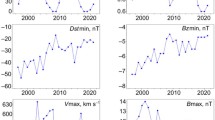Abstract
Based on satellite observation data, using dynamics equation, the ionospheric O+ ion’s distribution in the synchronous altitude region for different geomagnetic activity indexK p is studied by theoretical modeling and numerical analyzing, and semi-empirical models for the O+ ion’s density and flux versus longitude in the synchronous altitude region for differentK p are given. The main results show that in the synchronous altitude region: (i) The O+ ion’s density and flux in day-side are larger than those in nightside. (ii) With longitude changing, the higher the geomagnetic activity indexK p is, the higher the O+ ion’s density and flux, and their variation amplitude will be. The O+ ion’s density and flux whenK p ≥ 6 will be about ten times as great as that whenK p = 0. (iii) WhenK p = 0 orK p ≥ 6, the O+ ion’s density reaches maximum at longitudes 120° and 240° respectively, and minimum in the magnetotail. WhenK p = 3−5, the O+ ion’s density gets to maximum at longitude 0°, and minimum in the magnetotail. However, the O+ ion’s flux reaches maximum at longitude 120° and 240° respectively, and minimum in the magnetotail for anyK p value.
Similar content being viewed by others
References
Shelley, E. G., Johnson, R. G., Sharp, R. D., Satellite observations of energetic heavy ions during a geomagnetic storm, J. Geophys. Res., 1972, 77(31): 6104–6110.
Moore, T. E., Origing of Magnetospheric Plasma, Rev. Geophys., Suppl., 1991, (29): 1039–1048.
Jiao Wenxin, Pu Zuyin, A physics mechanics for charging inside of the spacecraft, Science in China (in Chinese), Ser. A, 2000, 30(supp.): 136–139.
Sharp, R. D., Lennartsson, W., Peterson, W. K. et al., The origin of the plasma in the distant plasma sheet, J. Geophys. Res., 1982, 87(A12): 10420–10424.
Lennartsson, W., Dynamical features of the plasma sheet ion composition, density, and energy, in Magnetotail Physics (ed. Liu, T. Y.), Baltimore: Johns Hopkins University Press, 1987, 35–55.
Horwitz, J. L., Lockwood, M., Waiter, J. H. et al., Transport of accelerated low-energy ions in the polar magnetosphere, in Magnetotail Physics (ed. Liu, T. Y.), Baltimore: Johns Hopkins University Press, 1987, 56–60.
Delcourt, D. C., Chappell, C. R., Moore, T. E. et al., A three-dimensional numerical model of ionospheric plasma in the magnetosphere, J. Geophys. Res., 1989, 94(A9): 11893–11920.
Delcourt, D. C., Sauvaud, J. A., Pedersen, A., Dynamics of single particle orbits during substorm expansion phase, J. Geophys. Res., 1990, 95(A12): 20853–20865.
Cladis, J. B., Francic, W. E., Distribution in magnetotail of O+ ions from Cusp/Cleft ionosphere: Possible substorm trigger, J. Geophys. Res., 1992, 97(A1): 123–131.
Shi Jiankui, Liu Zhenxing, Pu Zuyin, Theoretical study on the flux of up-flowing ion in the magnetosphere, Chinese Journal of Space Science (in Chinese), 1996, 16: 187–192.
Shi Jiankui, Liu Zhenxing, Theoretical distribution of up-flowing ions in the magnetosphere, Adv. Space Res., 1999, 24(1): 125–128.
Shi Jiankui, Liu Zhenxing, Zhang, T. L. et al., Acceleration of ionospheric out-flowing ions in the substorm in geo-magnetotail, Chin. Phys. Lett., 1999, 16(12): 908–910.
Pu Zuyin, Lui Zhenxing, Wang Yuandian, The dynamics equation of guiding center and its application in spacer physics, Chinese Journal Geophysics (in Chinese), 1981, 24: 372–384.
Eviater, A., Lencheek, A. M., Singer, S. F., Distribution of density in an ion-exosphere of a nonrotating planet, Phys. Fluids, 1964, 7: 1775–1779.
Shi Jiankui, Liu Zhenxing, Zhang, T. L. et al., Influence of the solar wind on O+ ion’s distribution in martian magnetosphere, Science in China, Ser. E, 2001, 44(6): 421–426.
Mead, G. D., Fairfield, D. H., A quantitative magnetospheric model derived from spacecraft magnetometer data, J. Geophys. Res., 1975, 80(4): 523.
Xu Wenyao, Wei Zhigang, Reversed polarity patch on the CMB and geomagnetic field reversal, Science in China, Ser. D, 2002, 45(6): 540–549.
Yau, A. W., Lockwood, M., Vertical ion flow in the polar ionosphere, in Modeling Magnetospheric Plasma, Geophys. Mono (eds. Moore, T. E., Waite, J. H., Jr.), Series 44, Washington DC: AGU, 1998, 229–237.
Author information
Authors and Affiliations
Corresponding author
Rights and permissions
About this article
Cite this article
Jiankui, S., Zhenxing, L., Zhang, T.L. et al. Distribution of ionospheric O+ ion in synchronous altitude region. Sci. China Ser. D-Earth Sci. 46, 986–993 (2003). https://doi.org/10.1007/BF02959393
Received:
Issue Date:
DOI: https://doi.org/10.1007/BF02959393



